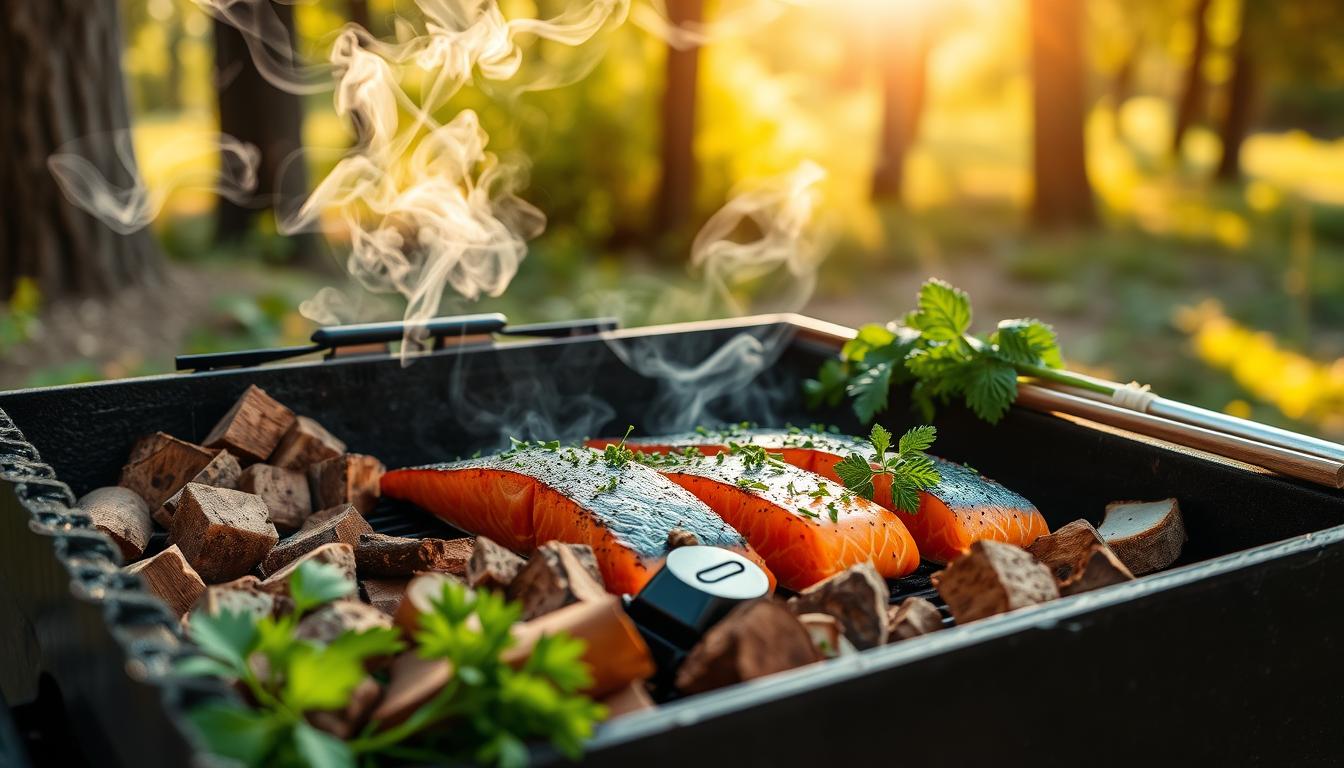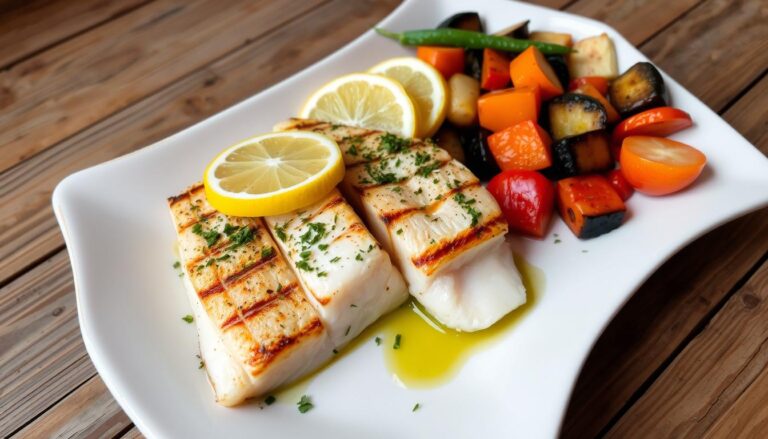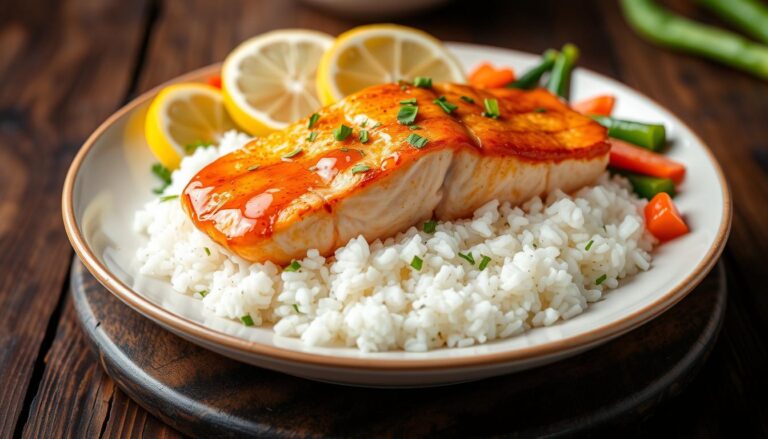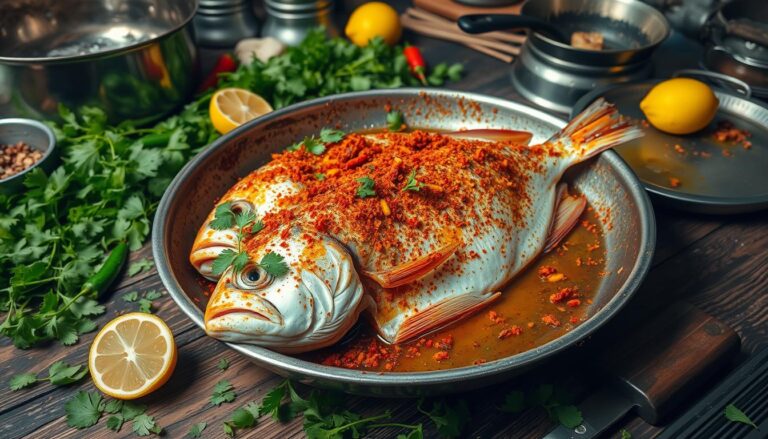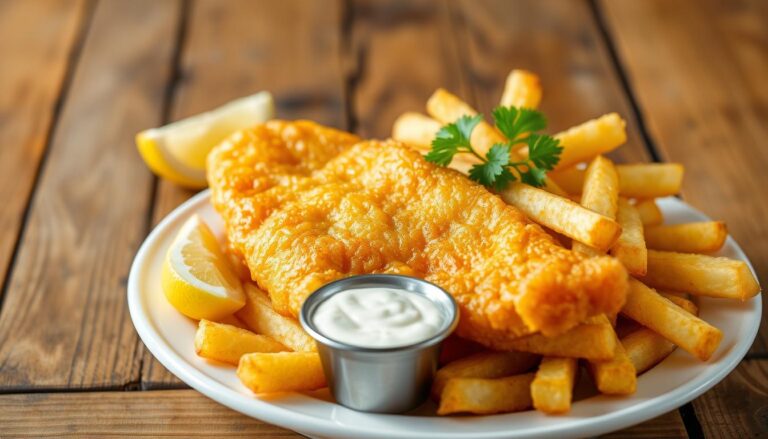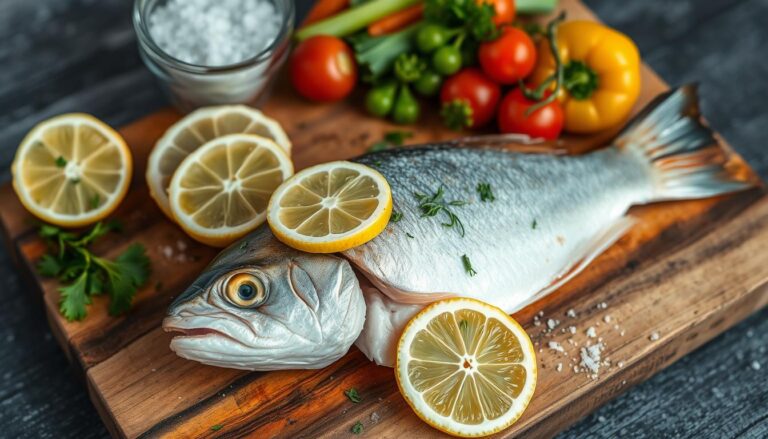How to Smoke Salmon in a Smoker?
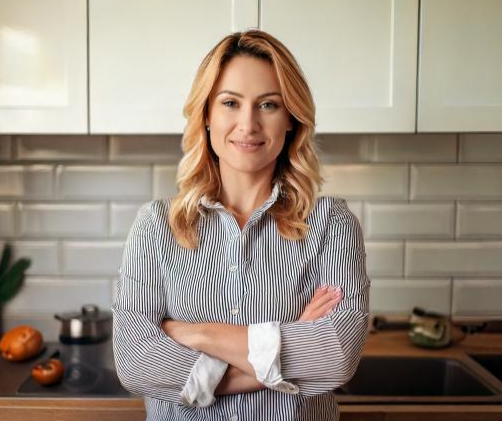
How to Smoke Salmon in a Smoker?
The smell of smoked salmon is irresistible. It makes anyone who loves food want to try it. I’ve spent a lot of time learning how to smoke salmon. I’m excited to share what I’ve learned with you.
Whether you’re experienced or new to smoking, this guide is for you. It covers everything from picking the right salmon to mastering your smoker’s temperature and timing. You’ll be able to make delicious smoked salmon that will impress everyone.
Smoking salmon is a tradition that brings out the fish’s natural flavors. Different types of salmon, like wild king or sockeye, taste amazing when smoked. In this guide, you’ll learn how to choose the best salmon, prepare it, and smoke it to perfection.
Table of contents
Introduction to Smoking Salmon
Smoking salmon is a centuries-old method to preserve and flavor this fish. It’s great for both experienced cooks and beginners. Knowing how to smoke salmon can lead to tasty dishes.
Background on Smoked Salmon
Smoked salmon’s history goes back to ancient times. It was first used to keep fish fresh longer. Later, it became a way to add special flavors and textures.
Now, smoked salmon is loved worldwide. Its rich taste makes it perfect for many dishes, from fancy appetizers to brunch.
Hot vs. Cold Smoked Salmon
- Hot-smoked salmon cooks at 225°F to 250°F. This method cooks the fish and adds a strong smoky flavor.
- Cold-smoked salmon smokes at 70°F to 90°F. It keeps the fish raw and preserves its delicate texture.
Both hot and cold smoked salmon have their own tastes and uses. Knowing the difference helps you pick the best method for your recipes.
“Smoking salmon is a time-honored tradition that has been passed down through generations, and it’s a skill that can be mastered with patience and attention to detail.” – [Expert Name], Culinary Historian
Selecting the Right Salmon for Smoking
Choosing the perfect salmon for smoking is key to great taste. You have many options for types of salmon to use for smoking. Wild-caught salmon is often the top pick because it tastes richer and is firmer than farm-raised.
But, high-quality farm-raised salmon can also be great for smoking. It’s good if you want salmon that’s the same size and shape. The best salmon for smoking are the fattier cuts, like the belly or center. These keep moisture and flavor well during smoking.
Factors to Consider When Choosing Salmon for Smoking
- Fat content: Look for salmon with a higher fat content, as this will result in a more tender and flavorful final product.
- Freshness: Ensure the salmon is fresh and of high quality, as the smoking process won’t mask any undesirable flavors or textures.
- Size and thickness: Opt for salmon fillets or steaks that are relatively uniform in size and thickness, as this will ensure even cooking and smoking.
- Origin: Consider the source of the salmon, whether it’s wild-caught or farm-raised, as this can affect the flavor and texture.
By carefully selecting the right salmon for smoking, you’ll be well on your way to creating a delicious and satisfying smoked salmon experience.
Preparing Salmon for Smoking
Getting your smoked salmon just right starts with proper preparation. First, brine the salmon to boost its flavor and keep it moist. A basic brine recipe involves soaking the fish in saltwater for 1 hour per pound, or up to 12 hours. This step helps keep the fish’s juices in and adds a nice salty-savory taste.
Next, create a pellicle on the salmon. This thin, sticky layer is key for the smoke to stick and add flavor. Just chill the brined salmon for up to 24 hours to let it dry and get that glossy texture.
Seasoning Salmon for Smoking
Once the salmon is brined and has a pellicle, it’s time to season it. This is where you can get creative with spices and herbs. Try a mix of lemon pepper, garlic powder, and brown sugar for a classic taste. The goal is to add flavors that complement the salmon without hiding the smoky taste.
By brining, creating a pellicle, and seasoning, you’ll make sure your smoked salmon is moist, flavorful, and a hit with everyone.
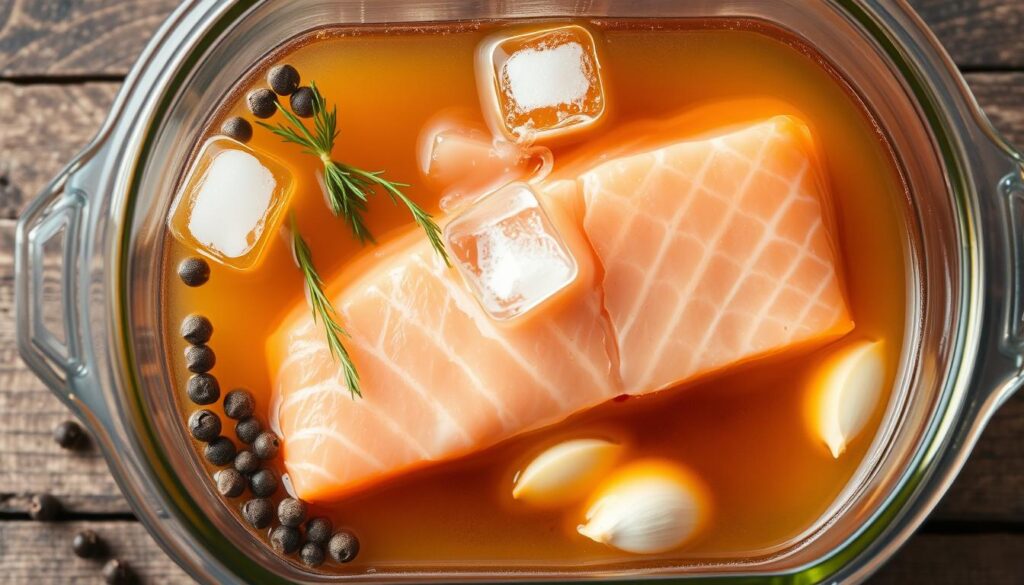
Setting Up Your Smoker
Creating delicious smoked salmon begins with picking the right smoker and wood chips. Each smoker type, from charcoal to pellet grills, has its own benefits and things to consider. The wood chips you choose also play a big role in the flavor of your smoked salmon.
Choosing the Ideal Smoker
The smoker you pick can really change how your salmon tastes. Charcoal smokers give a traditional, smoky flavor. Electric smokers let you control the temperature for even cooking. If you want something easy, a pellet grill is great for keeping the temperature just right.
Selecting the Best Wood Chips
The wood chips you use can make your smoked salmon taste even better. Alder wood is a favorite because it adds a light, sweet smokiness. You can also try apple or cherry wood for different flavors. Try different woods to see what you like best.
| Smoker Type | Pros | Cons |
|---|---|---|
| Charcoal Smoker | Authentic wood-fired flavor | Requires more hands-on attention |
| Electric Smoker | Precise temperature control | May lack the same depth of flavor |
| Pellet Grill | Convenient set-and-forget operation | Limited smoke intensity compared to other options |
Choosing the right smoker and wood chips depends on what you like and the flavor you want. Try different setups to find the best one for your smoked salmon.
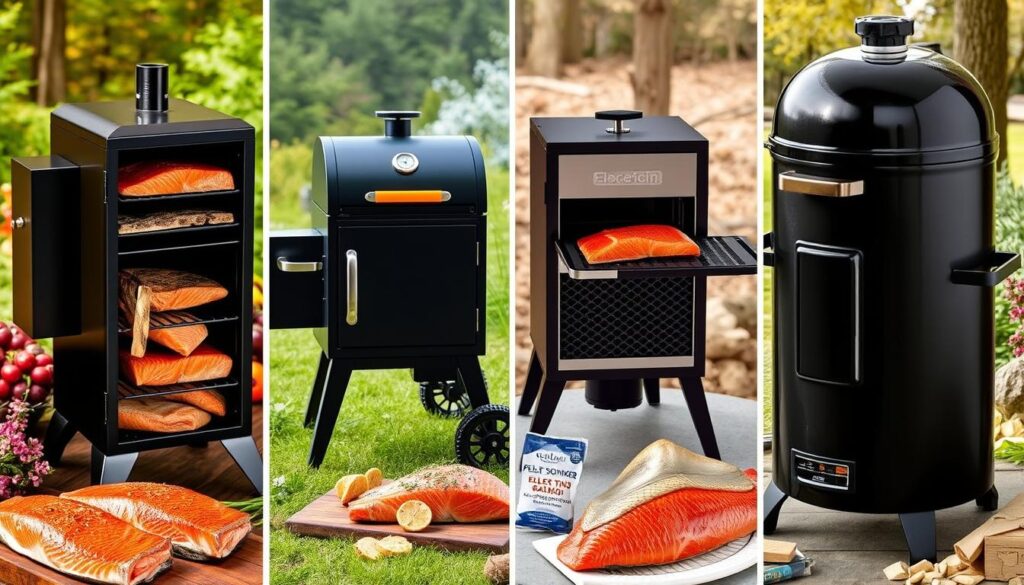
How to Smoke Salmon in a Smoker
Temperature and Time for Smoking
To make perfect smoked salmon, start by preheating your smoker to 225°F. Then, lower it to 180°F for smoking. This lower temperature helps the salmon soak up smoky flavors without getting too dry. The smoking time varies, from 2 to 3 hours, depending on the salmon’s thickness. It should reach 135°F to 140°F at its thickest part.
Basting and Monitoring the Smoking Process
To keep your smoked salmon moist and tasty, baste it often. Use melted butter or olive oil for the basting. Also, watch the salmon’s internal temperature closely. Cook it until it hits 145°F for the juiciest results.
| Salmon Variety | Recommended Fillet Size | Brining Time | Smoking Temperature | Smoking Time | Internal Temp. Target |
|---|---|---|---|---|---|
| Chinook (King), Coho, or Sockeye | Approximately 2 pounds | 13-15 hours | 180°F | 2-3 hours | 135°F-140°F, up to 145°F |
By sticking to these temperature, time, basting, and monitoring tips, you’ll make delicious smoked salmon at home. Remember, patience and careful attention are key to success.
how to smoke salmon in a smoker
Smoking salmon in a smoker adds rich, complex flavors to your catch. It’s easy to do, whether you’re experienced or new to cooking. Just follow these simple steps to make delicious hot-smoked salmon in your backyard.
- Start by brining the salmon for 5 hours. This keeps the fish moist and helps it soak up the smoke flavor.
- Next, set your smoker to about 225°F. Hot-smoked salmon cooks best at this temperature.
- Put the brined salmon fillets in the smoker. Smoke them for 1-2 hours, until they reach 145°F inside.
- Every now and then, brush the salmon with a light glaze or sauce. This adds extra flavor and keeps it moist.
- Keep a close eye on the smoking process. Adjust the temperature and airflow as needed to keep it just right.
With a little practice, you’ll make hot-smoked salmon that’s tender, juicy, and full of smoky flavor. Enjoy it as part of a meal or as a tasty snack.
“The secret to great smoked salmon is all in the preparation – brining and seasoning the fish properly before smoking is key to achieving that perfect texture and flavor.”
Conclusion
Congratulations, you’ve learned how to smoke salmon at home! You now know how to make delicious homemade smoked salmon. This can make many dishes even better.
Using your smoked salmon in recipes is fun. Add it to salads, pasta, or omelets for a tasty meal. It’s also great as an appetizer on crackers or toasted bread. Or, use it to make canapés and hors d’oeuvres special.
Keep your smoked salmon in the fridge for up to 4 days or freeze it for 3 months. When you’re ready to eat it, warm it up in the oven or on the stovetop. This will make it taste and feel just right again.
